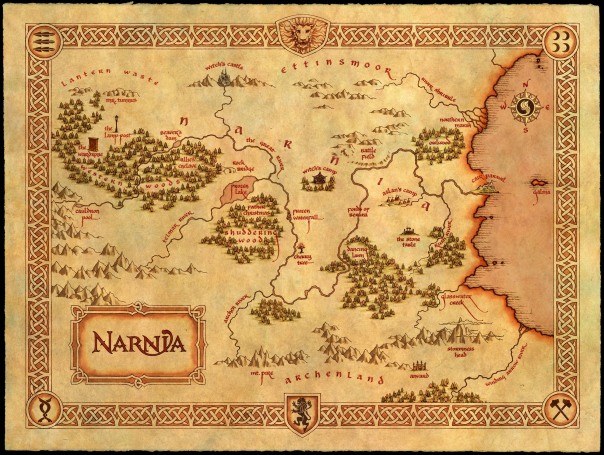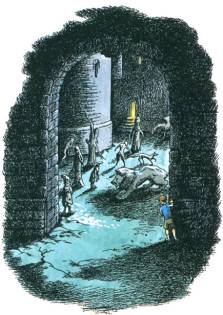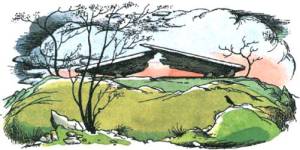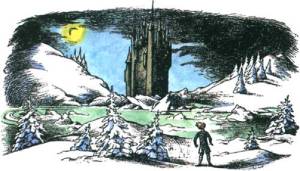Setting and Plot
The Land of Narnia
The land of Narnia was first explored by C.S. Lewis in 1950, and it was developed throughout a seven-part series that later became known as The Chronicles of Narnia.
The Pevensie children first discover Narnia inside the magical wardrobe in the old Professor’s house when they are exploring one day.

The land of Narnia spreads all the way from the Western Woods, where the children first discover Narnia at the Lamp-post, to the Great Eastern Ocean. Just on the edge of the ocean is the castle of Cair Paravel, which is where the true Kings and Queens shall one day rule over Narnia. The White Witch, in contrast, controls Narnia from her castle in the north.
The Lamp-Post
The first thing that the Pevensie children discover upon their entrance to Narnia, the Lamp-post has stood in Narnia since Narnia was first created. It was created after the White Witch ripped off a piece of a lamp-post in London and then tried to throw it at Aslan as he was bringing life to Narnia. It landed in the ground, and through Aslan’s magic it began to grow. It is now an organic thing that is just as alive as the plants and trees of Narnia, and its existence is what named the surrounding area Lantern Waste.
The Witch’s Castle
Located on the upper edge of Northern Narnia, the Witch’s Castle is where the White Witch controls all of Narnia. Her castle is visited first by Edmund, and later by Aslan, Susan, and Lucy (off-screen). Within the courtyard are all the enemies of the Witch who have been turned to stone, including Lucy’s friend, Mr. Tumnus the faun.

At the play’s beginning, the land of Narnia has been trapped in deep winter for one hundred years, ever since the White Witch first came to power and declared herself the Queen of Narnia. Although Narnia remains in perpetual winter, the Witch has made it so they can never have Christmas or any other holidays, and has forced Father Christmas to stay away from Narnia. Even though the White Witch rules Narnia, however, most Narnians do not recognize her claim to the throne, and instead are waiting for the return of the true King, Aslan, as well as the four humans of the prophecy.
As Narnia is a magical land, there are many fantastic creatures that live there. For example, all of the animals of Narnia can talk, such as Mr. and Mrs. Beaver. There are also centaurs, unicorns, and fauns, among many other magical creatures.
When the Pevensie children arrive in Narnia, they find that many of the inhabitants are at war with one another. Some Narnians believe that the White Witch is truly the Queen of Narnia, while others believe she stole the throne; however, because the citizens are at war with one another, no one knows who they can trust. The Pevensie children are warned that there might be spies for the White Witch in the Western Wood, one of which turns out to be Mr. Tumnus, Lucy’s friend! Initially an employee of the Witch’s, after Mr. Tumnus meets Lucy he quickly changes his allegiance to help Lucy and Aslan.
Narnia is in a state of unrest, and it is only with the arrival of Aslan and the Pevensie children that the Narnian struggle with the White Witch can be solved.
In order to do this, the children must travel from the Western Woods with Mr. and Mrs. Beaver to meet with Aslan at the Stone Table.

The Stone Table
The Stone Table proves to be crucial to the plot of The Lion, the Witch, and the Wardrobe. A place of Deep Magic, the Stone Table is located in central Narnia and becomes the place of Aslan’s sacrifice. The Table was created by Aslan’s father, and etched into the stone is the law of the Deep Magic which states that “if a willing Victim that has committed no treachery is killed in a traitor’s stead, the Stone Table will crack; and even death itself would turn backwards.”[1]
The Prophecy
“Wrong will be right when Aslan comes in sight.
At the sound of his roar, sorrows will be no more.
When he bares his teeth, winter will meet its death.
And when he shakes his mane, we shall have spring again.
When Adam’s flesh and Adam’s bone
Sits at Cair Paravel in throne,
The evil time will be over and done.”[2]
The events of The Lion, the Witch, and the Wardrobe are primarily centered around the Narnians’ desire to fulfill the prophecy and end the White Witch’s reign, and the White Witch’s desire to prevent the prophecy from coming true.
[Fact check! The prophecy refers to humans as “Adam’s flesh and Adam’s bone,” an allusion to Adam and Eve, who are considered the first human beings by the Abrahamic religions (Judaism, Christianity, and Islam).]
In order to fulfill the prophecy, two things must happen: first, Aslan must return to Narnia, and second, two human boys and two human girls must come to Narnia. Until this happens, the Narnians will never be able to defeat the White Witch and instate the rightful rulers.
Because the White Witch is aware of the prophecy, she is extremely wary of any humans who arrive in Narnia. Therefore, when she meets Edmund on his first trip to Narnia, she tricks him into agreeing to bring his brother and sisters to the Witch’s castle the next time they are in Narnia.
However, when the time comes, Edmund is unable to convince Peter, Susan, and Lucy to go to the Witch’s castle. Instead, the Pevensie children meet Mr. and Mrs. Beaver, who are the ones to tell the children about the prophecy. Edmund sneaks away to search out the White Witch, while the rest of the Pevensie children agree to begin the search for Aslan.

While the Peter, Susan, and Lucy begin to make their way to the Stone Table, Edmund finds himself at the Witch’s castle. Unfortunately, he has not brought his brother and sisters to the Witch like she ordered, and so she quickly becomes angry. As the White Witch’s anger grows, Edmund is quick to realize his mistake. His anger and resentment towards his siblings is part of the reason why he is now in trouble.
The White Witch then realizes that her plans can still work: if she kills Edmund, then there will be only one Son of Adam to sit on the throne at Cair Paravel, and so the prophecy will not be able to come true.
The White Witch begins her trek to the Stone Table as well so she can kill Edmund. But while everyone travels on their way to the Stone Table, something begins to happen. The snow begins to melt for the first time in over one hundred years, the beginning of the fulfillment of the prophecy!
Aslan’s army arrives and saves Edmund before the White Witch is able to kill him, and they return Edmund to his siblings. The White Witch returns before they can celebrate, however, and demands that Edmund is returned to her as she has the right to all traitors thanks to the Deep Magic of the land. Instead, Aslan makes a secret deal with the Witch and she renounces her claims on Edmund.
The deal is revealed that Aslan will be killed in Edmund’s place; however, thanks to the laws of Deep Magic Aslan is brought back to life. The Narnians go to war against the White Witch once and for all, and with Aslan and the four Pevensie children as their leaders they are victorious. Edmund in particular, in recognition of the sacrifice that Aslan made for him, is able to grow and recognize the mistakes that he has made before doing his best to fix them.
The four children are crowned the Kings and Queens of Narnia, and are titled respectively:
High King Peter the Magnificent
Queen Susan the Gentle
King Edmund the Just
Queen Lucy the Valiant
The prophecy is fulfilled: the evil time is over, and the Pevensie children usher in the Golden Age of Narnia.
[1]C.S. Lewis, The Lion, the Witch, and the Wardrobe, (New York: Scholastic), 163.
[2]Joseph Robinette, The Lion, the Witch, and the Wardrobe: A Full Length Play, (Woodstock: Dramatic Publishing), 27.
CCSS.ELA-LITERACY.RH.6-8.7 Integrate visual information (e.g., in charts, graphs, photographs, videos, or maps) with other information in print and digital texts.
CCSS.ELA-LITERACY.RL.6.3 Describe how a particular story’s or drama’s plot unfolds in a series of episodes as well as how the characters respond or change as the plot moves toward a resolution.
This section created by Talitha Wright